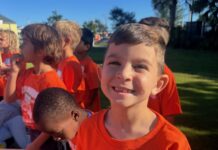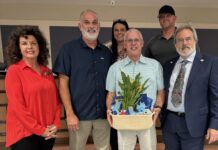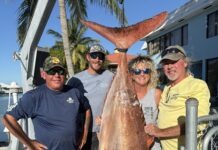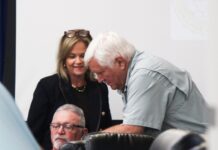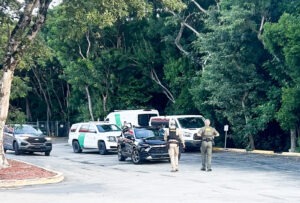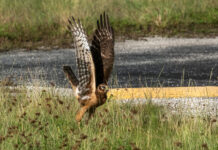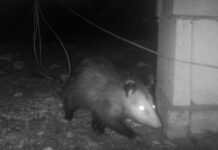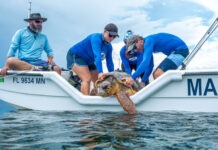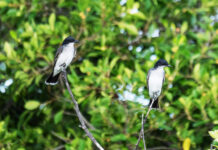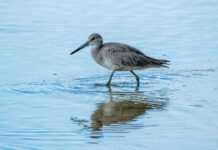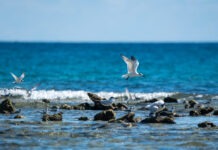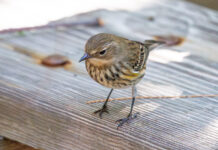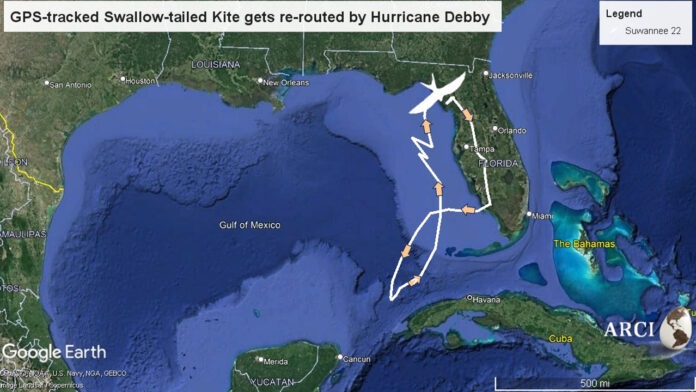
I drove some equipment up to the Florida Keys Hawkwatch site at Curry Hammock State Park in Marathon the other day. It was officially the first day of the season and my friend Rafael Galvez, director of the project, was there, along with one of the new counters, Adrianna Nelson. It was her first day.
This is the 25th anniversary of the start of the Florida Keys Hawkwatch, which traditionally started in early September. The project’s aim is to monitor the populations of raptors – hawks, falcons, kites, eagles, ospreys, vultures, etc. – that migrate through the Keys. Curry Hammock State Park is a great place to survey from because hawks on their way to the Caribbean and more southerly destinations prefer to fly over land as long as possible, because the shorter the water crossing, the safer the water crossing. Little Crawl Key and its neighbor, Long Point Key, are collectively only about a mile across, meaning you can catch sight of most of the birds that pass by.
Rather than starting in early September, though, this will be the third year the hawkwatch has started in early August. The reason? Swallow-tailed kites, which tend to migrate a month or so earlier than the rest of the raptor world, and whose migratory routes have not been surveyed until now.
I’ve been spending time up at the hawkwatch since its early days, when it was based on the back deck of the bathhouse in the middle of the Curry Hammock campground, which was basically a treeless gravel lot with RV hookups. It is still based on the back deck of the bathhouse in the middle of the Curry Hammock campground, though the back deck is about twice the size it used to be, and the gravel lot is now very full of some healthy looking trees, some of which are as tall, if not taller than, the bathhouse, making it a little more challenging to track the raptors that fly over. (Somehow I manage to be surprised at how high the trees have gotten every year.)
Rafael and Adrianna hadn’t seen many raptors yet – three turkey vultures and three osprey – and they were unlikely to in the coming days, as tropical-whatever-storm-category-it-was Debby was pushing north and going to be there by the next morning at the latest.
Rafael was going to be there for a few days before he had to drive north and on to some other life tasks, and Adrianna was going to have to run the count by herself for a week or so, until the additional two counters arrived from other field work jobs. But there wasn’t much to worry about. Adrianna was obviously sharp. She was the American Birding Association’s Young Birder of the Year in 2020. She was also kind enough to laugh at our jokes.
The only thing I worried about was the boredom she might have to deal with if the raptor numbers were going to be low, though there were other birds to look at. Hundreds of barn swallows and purple martins, a few cliff swallows, and a smattering of early warbler migrants had passed through that day, and would probably be less fickle than the raptors when it came to suitable weather.
While the Florida Keys Hawkwatch is the first project to start surveying migrating swallow-tailed kites that move through South Florida, they are not the only ones to try and track swallow-tails on their migration. The folks at the Avian Research and Conservation Institute (ARCI) based out of Gainesville have been trapping individual swallow-tails and attaching small trackers on them for over a decade.
The most recent tech they are using are GPS trackers made by Cellular Tracking Technologies that record location data, then transmit it via cellular networks whenever they are in contact with them. On Aug. 2 (the day I was at Curry Hammock) ARCI posted a map showing the locations of their baker’s dozen of tagged kites. Most of them were in Florida, but two of them had already crossed over to Mexico, landing in the Quintana Roo area on their way to winter in Brazil.
On Aug. 5, as the storm named Debby was making landfall on the coast of the panhandle, they posted something about the bird named Suwannee 22, who woke on Aug. 3 to “tail winds that should have easily carried her across the Gulf of Mexico to the migrating kites’ traditional waypoint on the Yucatan Peninsula.”
The headline of the post was “Riding the Storm Out,” which is the first REO Speedwagon reference I’ve seen in ornithological circles.
Somewhere around 60 miles north of Cuba she apparently hit heavy winds – the winds of Debby – and couldn’t make any more progress. “Suwannee 22 chose to go with the flow,” ARCI Senior Conservation Scientist Gina Kent wrote.
She rode the winds of the storm northward for 12 hours, coming within 45 miles of the coast of St. Petersburg around 6 p.m. on Aug. 4. From there she spent four hours trying, and failing, to make it to shore.
Kent believes she sought refuge in a different type of shelter.
“Given the time stamps of her subsequent GPS track and Debby’s radar-inscribed path, we are quite certain Suwannee 22 hitched a ride in the developing eye of the storm. It appears that, against all odds, the two simultaneously made landfall in Steinhatchee, a remote outpost in Florida’s Big Bend. By 8 a.m. on Aug. 5, Suwannee 22 was over land in the Big Bend Wildlife Management Area, likely resting after being blown over and through the tree canopy where she sought a strong perch,” Kent wrote.
This was less than 60 miles from where she first had her satellite tracker attached.
After such a harrowing journey, Suwannee 22 will no doubt need to rest up and bulk up before heading south again, but Kent says they will post when she is on the move again. (You can follow their posts on Facebook and their website, arcinst.org.)
Interestingly, the next day Adrianna Nelson sent out a message with a photo on the hawkwatch text string reporting an “insane (swallow-tailed kite) tornado” of about 600 birds in a single kettle.
I told her she was kind of overdoing it for her first week. She said to blame the kites.
Barring majorly inclement weather, the counters will be at Curry Hammock every day from now until the end of October. Stop by. You never know what you’ll see.




